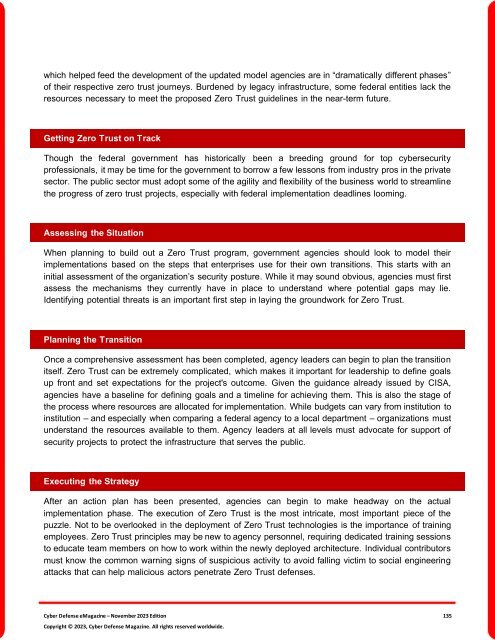The Cyber Defense eMagazine November Edition for 2023
Cyber Defense eMagazine November Edition for 2023 #CDM #CYBERDEFENSEMAG @CyberDefenseMag by @Miliefsky a world-renowned cyber security expert and the Publisher of Cyber Defense Magazine as part of the Cyber Defense Media Group as well as Yan Ross, Editor-in-Chief and many more writers, partners and supporters who make this an awesome publication! 196 page November Edition fully packed with some of our best content. Thank you all and to our readers! OSINT ROCKS! #CDM #CDMG #OSINT #CYBERSECURITY #INFOSEC #BEST #PRACTICES #TIPS #TECHNIQUES
Cyber Defense eMagazine November Edition for 2023 #CDM #CYBERDEFENSEMAG @CyberDefenseMag by @Miliefsky a world-renowned cyber security expert and the Publisher of Cyber Defense Magazine as part of the Cyber Defense Media Group as well as Yan Ross, Editor-in-Chief and many more writers, partners and supporters who make this an awesome publication! 196 page November Edition fully packed with some of our best content. Thank you all and to our readers! OSINT ROCKS! #CDM #CDMG #OSINT #CYBERSECURITY #INFOSEC #BEST #PRACTICES #TIPS #TECHNIQUES
Create successful ePaper yourself
Turn your PDF publications into a flip-book with our unique Google optimized e-Paper software.
which helped feed the development of the updated model agencies are in “dramatically different phases”<br />
of their respective zero trust journeys. Burdened by legacy infrastructure, some federal entities lack the<br />
resources necessary to meet the proposed Zero Trust guidelines in the near-term future.<br />
Getting Zero Trust on Track<br />
Though the federal government has historically been a breeding ground <strong>for</strong> top cybersecurity<br />
professionals, it may be time <strong>for</strong> the government to borrow a few lessons from industry pros in the private<br />
sector. <strong>The</strong> public sector must adopt some of the agility and flexibility of the business world to streamline<br />
the progress of zero trust projects, especially with federal implementation deadlines looming.<br />
Assessing the Situation<br />
When planning to build out a Zero Trust program, government agencies should look to model their<br />
implementations based on the steps that enterprises use <strong>for</strong> their own transitions. This starts with an<br />
initial assessment of the organization’s security posture. While it may sound obvious, agencies must first<br />
assess the mechanisms they currently have in place to understand where potential gaps may lie.<br />
Identifying potential threats is an important first step in laying the groundwork <strong>for</strong> Zero Trust.<br />
Planning the Transition<br />
Once a comprehensive assessment has been completed, agency leaders can begin to plan the transition<br />
itself. Zero Trust can be extremely complicated, which makes it important <strong>for</strong> leadership to define goals<br />
up front and set expectations <strong>for</strong> the project's outcome. Given the guidance already issued by CISA,<br />
agencies have a baseline <strong>for</strong> defining goals and a timeline <strong>for</strong> achieving them. This is also the stage of<br />
the process where resources are allocated <strong>for</strong> implementation. While budgets can vary from institution to<br />
institution – and especially when comparing a federal agency to a local department – organizations must<br />
understand the resources available to them. Agency leaders at all levels must advocate <strong>for</strong> support of<br />
security projects to protect the infrastructure that serves the public.<br />
Executing the Strategy<br />
After an action plan has been presented, agencies can begin to make headway on the actual<br />
implementation phase. <strong>The</strong> execution of Zero Trust is the most intricate, most important piece of the<br />
puzzle. Not to be overlooked in the deployment of Zero Trust technologies is the importance of training<br />
employees. Zero Trust principles may be new to agency personnel, requiring dedicated training sessions<br />
to educate team members on how to work within the newly deployed architecture. Individual contributors<br />
must know the common warning signs of suspicious activity to avoid falling victim to social engineering<br />
attacks that can help malicious actors penetrate Zero Trust defenses.<br />
<strong>Cyber</strong> <strong>Defense</strong> <strong>eMagazine</strong> – <strong>November</strong> <strong>2023</strong> <strong>Edition</strong> 135<br />
Copyright © <strong>2023</strong>, <strong>Cyber</strong> <strong>Defense</strong> Magazine. All rights reserved worldwide.

















